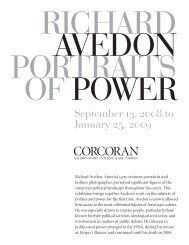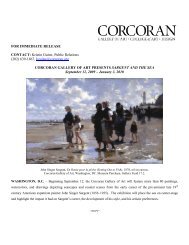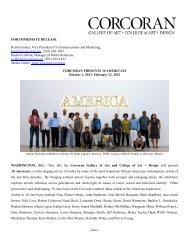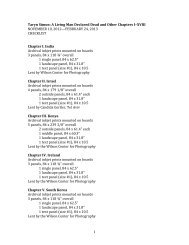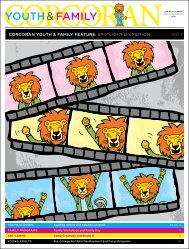Aaron Douglas, Into Bondage, 1936 - Corcoran Gallery of Art
Aaron Douglas, Into Bondage, 1936 - Corcoran Gallery of Art
Aaron Douglas, Into Bondage, 1936 - Corcoran Gallery of Art
You also want an ePaper? Increase the reach of your titles
YUMPU automatically turns print PDFs into web optimized ePapers that Google loves.
Joshua Johnson (born probably Baltimore, MD, 1761/63–<br />
died probably Baltimore, MD, after c. 1825)<br />
Grace Allison McCurdy (Mrs. Hugh McCurdy) and Her Daughters,<br />
Mary Jane and Letitia Grace, c. 1806<br />
Oil on canvas, 43 5/8 x 38 7/8 in. (110.8 x 98.8 cm)<br />
Museum Purchase through the gifts <strong>of</strong> William Wilson <strong>Corcoran</strong>, Elizabeth Donner Norment,<br />
Francis Biddle, Erich Cohn, Hardinge Scholle, and the William A. Clark Fund, 1983<br />
About the <strong>Art</strong>ist<br />
Joshua Johnson, the earliest known pr<strong>of</strong>essional African-American<br />
artist, was the son <strong>of</strong> George Johnson—a white man from Baltimore<br />
County, Maryland—and an unknown slave woman. Johnson gained<br />
legal freedom upon completion <strong>of</strong> an apprenticeship with a blacksmith<br />
in Baltimore. The first documentation to identify him as a<br />
painter comes from a self-placed ad in a 1798 issue <strong>of</strong> the Baltimore<br />
Intelligencer, in which Johnson referred to himself as a “self-taught<br />
genius.” This claim has been debated by scholars due to Johnson’s<br />
complex pictorial compositions and Baltimore’s artistic environment<br />
in the early 19th century, which included the prolific Peale family<br />
<strong>of</strong> painters—particularly Charles Peale Polk—who may have influenced<br />
Johnson’s aesthetic development. Johnson painted notable and<br />
wealthy members <strong>of</strong> Baltimore’s society, as well as the tradesmen<br />
and merchants <strong>of</strong> the middle class. While Maryland participated<br />
in slavery, Baltimore had a large population <strong>of</strong> free African Americans;<br />
Johnson painted both landowners and abolitionists.<br />
Though Johnson created over 100 works, he only signed one.<br />
Therefore, connoisseurs identify his images by his distinctive style.<br />
He did not date his paintings, leading scholars to estimate the<br />
chronology <strong>of</strong> each work based on the biographies <strong>of</strong> their<br />
respective subjects.<br />
About the <strong>Art</strong><br />
This portrait depicts Grace Allison McCurdy (1775–1822) and her<br />
two daughters, Letitia (on the right) and Mary Jane. A few years<br />
earlier, Grace and her husband—prominent Baltimore merchant<br />
Hugh McCurdy—had commissioned a portrait <strong>of</strong> older daughter<br />
Letitia from Johnson, which is now in the collection <strong>of</strong> the Fine<br />
<strong>Art</strong>s Museums <strong>of</strong> San Francisco. Speculation suggests that this<br />
painting <strong>of</strong> Mrs. McCurdy and her daughters was meant to be<br />
a portrait representing all four family members. But if this was the<br />
case, Hugh’s untimely death in 1805 altered that plan, effectively<br />
making this a mourning portrait.<br />
Johnson captures the individuality <strong>of</strong> each subject, while visually<br />
linking them as a family unit through similarities in appearance,<br />
compositional elements, and repetition <strong>of</strong> color. All three wear white<br />
empire-waist dresses with subtle differences in the decoration<br />
on the sleeves and collars. Mrs. McCurdy wears a headband, while<br />
both girls have necklaces; Mary Jane’s is made <strong>of</strong> coral beads which<br />
were believed to ward <strong>of</strong>f disease, and Letitia’s is a gold locket that<br />
may be engraved with her initials. Johnson depicts them with<br />
almond-shaped eyes, flushed cheeks, and pleasant, yet unsmiling<br />
expressions. The figures stand in front <strong>of</strong> a brass-tacked, upholstered<br />
s<strong>of</strong>a with a curved back, which passes behind each figure and<br />
echoes the diagonal line formed by their heads. Grace touches<br />
Mary Jane’s left shoulder. Mary Jane mimics her mother’s gesture<br />
by placing a hand on Mrs. McCurdy’s back. The sisters’ parallel arms<br />
and the green umbrella—which echoes the folds <strong>of</strong> Mary Jane’s<br />
dress—link the two girls. Repetition <strong>of</strong> color also creates a connection<br />
among the three, as the strawberry cluster, Mary Jane’s shoe,<br />
and the basket <strong>of</strong> berries form a horizontal line <strong>of</strong> red highlights.<br />
The implied narrative suggested by the strawberry-filled basket<br />
and the umbrella is rare in Johnson’s work.<br />
Suggested Dialogue<br />
• What sort <strong>of</strong> activity do you think is implied by the basket<br />
<strong>of</strong> strawberries and the umbrella?<br />
• How would your family want to be depicted in a portrait?<br />
Where would the painting be set? What would you be wearing?<br />
What objects could be incorporated to show your family’s interests?<br />
• What expressions do you see on the figures’ faces?<br />
Are they somber? Happy? Bored?<br />
• Are there clues in the clothing as to the social status <strong>of</strong> the family?<br />
Extended Dialogue<br />
• Traditionally, patrons who commissioned a portrait would <strong>of</strong>ten<br />
decide how they dressed and what objects might be included<br />
in the finished work. How is that similar or different from the way<br />
that artists work today? What do you think the McCurdy family<br />
told Johnson about how they would like to be depicted?<br />
• How do you think the social and political atmosphere <strong>of</strong> early<br />
19th-century Baltimore influenced Johnson’s work as an African<br />
American artist?<br />
• Do you think the McCurdy family’s selection <strong>of</strong> Johnson as their<br />
portraitist reflects their social or political views?<br />
Vocabulary<br />
Peale family: Charles Wilson Peale<br />
(1741–1827) was the father <strong>of</strong> 17 children,<br />
including four artist sons named after<br />
famous Renaissance and Baroque painters.<br />
The most enduring legacy <strong>of</strong> this remarkable<br />
family was their collective influence<br />
on their contemporaries and on successive<br />
generations <strong>of</strong> artists working in Philadelphia<br />
and the northeastern United States.<br />
Abolitionist: A person associated with<br />
the Abolitionist Movement in 19th-century<br />
America. This movement strived to gain<br />
freedom for all slaves and end racial<br />
discrimination.<br />
Portrait: A portrait is a painting, photograph,<br />
sculpture, or other artistic representation<br />
<strong>of</strong> a person, in which the face<br />
and its expression is predominant. The<br />
intent is to display the likeness, personality,<br />
and even the mood <strong>of</strong> the person.<br />
Commission: A patron hires an artist<br />
and pays them for a specific assignment.<br />
Because portraits were the most valuable<br />
art form in the early 19th century, patrons<br />
wanted portraits that captured special<br />
occasions, marked social status, depicted<br />
deceased relatives in an honorable manner,<br />
or were presented as gifts.<br />
Empire-waist: A dress style in which<br />
the waistline falls directly below the bust.<br />
The style became very popular in the early<br />
19th century, the time <strong>of</strong> the McCurdy’s<br />
family portrait.<br />
Patron: An individual or institution providing<br />
financial support for artists to produce<br />
specific works <strong>of</strong> art. Many patrons<br />
influenced the subject matter and themes<br />
<strong>of</strong> artists’ work in accordance with their<br />
own preferences.<br />
Support for <strong>Art</strong>s 101 materials is made possible in part by the Women’s Committee <strong>of</strong> the <strong>Corcoran</strong> and the DC Commission on the <strong>Art</strong>s and Humanities.


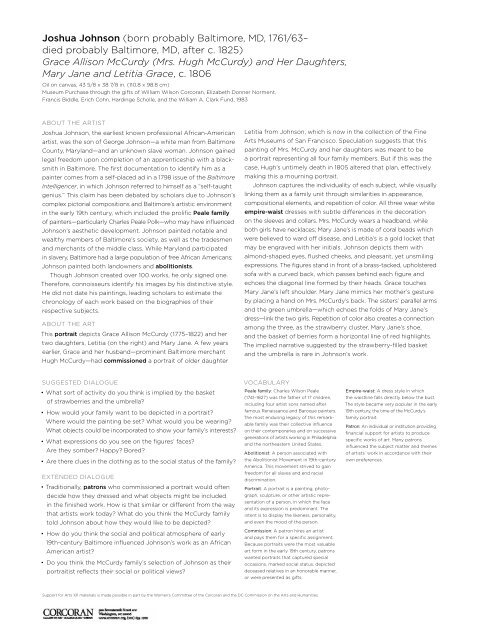
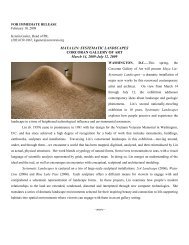
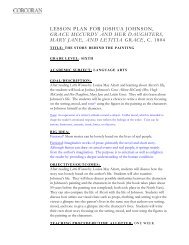
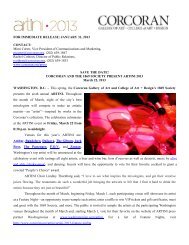


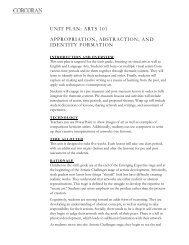
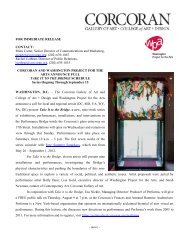


![[PDF] Ellen Harvey: The Alien's Guide to the Ruins of Washington, DC](https://img.yumpu.com/32942537/1/190x190/pdf-ellen-harvey-the-aliens-guide-to-the-ruins-of-washington-dc.jpg?quality=85)
